IBDP Online Test Series By iitianacademy
Comprehensive Test Preparatory package targeted towards IBDP
Question
Beans contribute to flatulence. Alpha-galactosidase, derived from the fungus Aspergillus niger, is an enzyme that breaks down the fibre usually fermented by bacteria, reducing intestinal gas. Describe how alpha-galactosidase would be produced using A. niger in a continuous fermenter.
Temperature is a variable that needs to be continually monitored in deep-tank batch fermentation of penicillin. List two other variables that need to be monitored.
Answer/Explanation
Markscheme
a. constant nutrient medium «supply» needed/maintained
b. optimal mixing
c. fermented in sterile bioreactor
d. alpha-galactosidase production/general conditions assayed/screened/monitored «throughout the process»
e. continuous removal of alpha-galactosidase/products
[Max 3 Marks]
a. pH
b. «dissolved» oxygen
Question
Distinguish between batch fermentation and continuous fermentation.
Aspergillus niger is used to produce citric acid by continuous fermentation. Glucose is converted to pyruvate by glycolysis. Trehalose-6-phosphate normally inhibits hexokinase, an important enzyme in the glycolysis pathway.
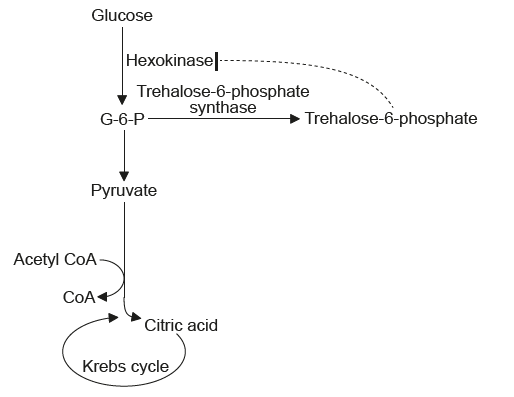
Suggest how pathway engineering could be used to address this factor which reduces yields of citric acid.
Answer/Explanation
Markscheme

a. «genetically modify to» incorporate gene for low/blockage of TPS activity into A. niger
b. «genetically modify to» incorporate gene that breaks down trehalose-6-phosphate
c. selectively breed A. niger cultures for low/no TPS activity
Question
Distinguish between the structure of Gram-positive and Gram-negative bacteria.
Answer/Explanation
Markscheme
a. Gram-negative bacteria have a thinner peptidoglycan cell wall / Gram-positive bacteria have a thicker peptidoglycan cell wall
b. Gram-negative bacteria have an additional membrane of «lipopolysaccharide and protein» outside the wall «whereas Gram-positive bacteria do not»
Question
Lipid A is a phospholipid that makes up the external layer of the outer membranes of most Gram-negative bacteria. LpxC is an enzyme involved in the biosynthesis of lipid A. In this experiment, a lawn of the Gram-negative bacterium Escherichia coli was grown on a nutrient agar plate. Shortly after inoculation, before the lawn is formed, discs containing different test compounds were placed on top. The Petri dish shows the results after 24 hours incubation.
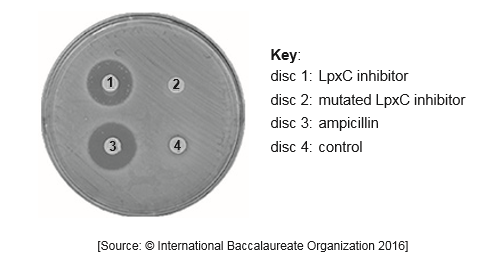
Outline the effect of disc 3 on the bacterial lawn.
Outline the effect of mutating the LpxC inhibitor.
Predict the results obtained with disc 1 in a Gram-positive bacterial lawn.
Answer/Explanation
Markscheme
a. the antibiotic/ampicillin diffuses out
b. killing bacteria/inhibiting growth of bacteria
c. zone of inhibition/clearing formed
lipid A production/synthesis is not inhibited so bacteria can grow
OR
bacteria grow/are not affected since inhibitor function is lost
no inhibition of growth, since Gram-positive do not have lipid A in membrane/OWTTE
Question
Succinate is industrially produced by continuous fermentation. It is used as a raw material in the production of flavour enhancers, drugs and industrial chemicals. One method of increasing the production of succinate is to genetically modify E. coli to express high levels of formate dehydrogenase (FDH1). This results in the production of higher concentrations of NADH. The engineered pathway is shown as a bold dotted line in the image.
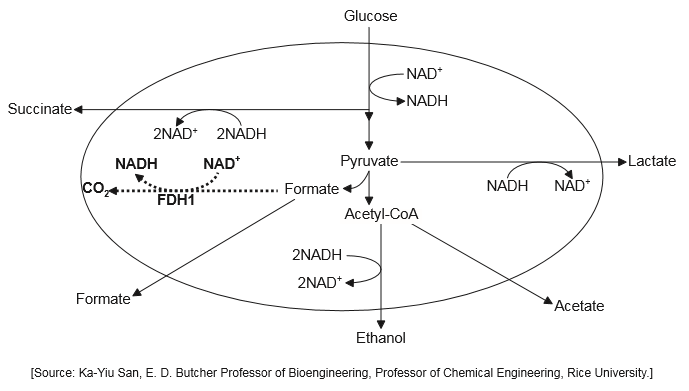
Using the diagram, suggest a reason for high concentrations of NADH favouring the production of succinate.
Predict one metabolite other than succinate that will be produced in greater amounts if the amount of NADH available is increased.
Outline the process of continuous culture fermentation.
Outline one reason this process, to increase the production of succinate, represents pathway engineering.
Answer/Explanation
Markscheme
NADH is required as a reducing agent/electron donor/hydrogen donor/co-enzyme/limiting factor for the production of succinate
High levels of FDH1 produce greater quantities of NADH which is required for conversion of glucose «via intermediates» to succinate
Lactate/ethanol
CO2 «favoured by high FDH1 levels»
Raw materials are supplied in continuous amounts
Products/wastes are continuously extracted
Conditions are monitored/regulated to keep variables at a steady state
Genetic processes/rate limiting chemicals/regulatory processes are being optimized
Question
List two roles for microbes in ecosystems.
Answer/Explanation
Markscheme
producers/nitrogen fixers/decomposers/parasites/pathogens/nitrifiers/denitrifiers (accept other correct roles)
Award [1] for any two.
Question
The bacterium Escherichia coli is responsible for over 70 000 cases of illness each year in the US. More than half of these cases are due to transmission of the bacteria in food, particularly from ground beef in undercooked burgers. Epidemiologists collected evidence from 183 outbreaks of food poisoning between the years 1982 and 2002 and identified the food responsible for the outbreak. They divided the foods into dairy products, fruit and vegetables, beef, ground beef (beef which has been minced) and other foods. In some cases they were unable to identify the food that had caused the outbreak. The results are displayed in the bar chart.
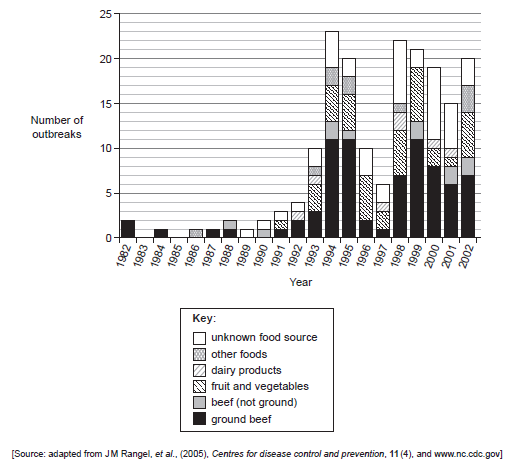
State the number of years during the study when contaminated dairy products caused food poisoning.
Compare the outbreaks of food poisoning in 1989 and 1994.
Suggest two reasons for these changes.
Explain how pasteurization may have prevented food poisoning by dairy products.
Answer/Explanation
Markscheme
6 (years) (units not required)
a. total number of outbreaks of food poisoning (much) greater in 1994/ changed from 1 to 23;
b. more unknown outbreaks in 1994 than in 1989;
c. food poisoning in 1994 due to ground beef/beef/fruit and vegetables/other sources which did not occur in 1989;
d. greatest increase in food poisoning due to ground beef;
e. no food poisoning due to dairy products in either year / increase in food poisoning from other sources from 1989 to 1994;
a. increase in range of foods available;
b. increase in fast food outlets (short time of cooking) / change in preparation methods / OWTTE;
c. increase in technological advances to analyse outbreaks / more awareness (of occurrence of contaminations) / better data collection / OWTTE;
d. increase in bacterial resistance;
a. milk is quickly heated;
b. to high temperatures then rapidly cooled down;
c. this kills harmful bacteria;
Question
In 2003, the Integrated Approach to Community Development (IACD) organization introduced the chulli water purifier to homes in Bangladesh that had not previously had access to safe drinking water. It was designed to be made cheaply from local materials. The purifier uses sand filtration to remove organic particles and heat pasteurization to eliminate microbes from water.
Water samples from 15 different locations containing high levels of the bacterium E. coli were passed through the purifier at different flow rates and temperatures to test its effect on contaminated water. The shaded area of the graph below represents the recommended temperature and flow rate for using the purifier.
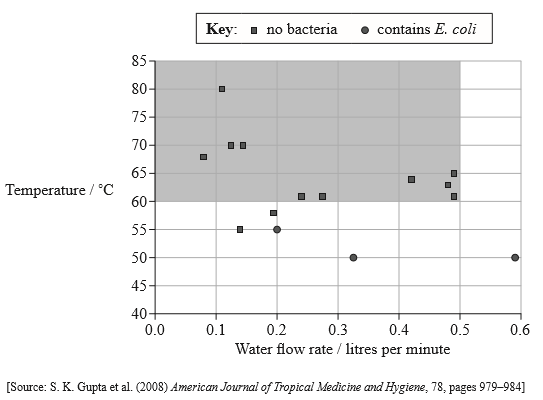
State the highest temperature at which bacteria were found in water that had passed through the chulli purifier.
Calculate the maximum volume of safe drinking water that could be produced by the chulli purifier in one hour.
Discuss whether 80°C is the best temperature to operate the chulli purifier.
The results suggest that there may be a relationship between the water flow rate and the minimum temperature needed to eliminate microbes. State this relationship.
Evaluate pasteurization as a method of controlling microbial growth.
Answer/Explanation
Markscheme
55°C (units required)
30 litres (accept answers in the range of 28.8 to 30.0 litres)
Working not required.
a. good because it kills/is free of bacteria;
b. no bacteria between 80° and 60° even at higher flow rates;
c. not good as it would use too much energy/be expensive to heat water;
the slower the flow rate, the lower the temperature.
implications:
a. kills bacteria/most pathogens by heating food/liquids to specific/high/ 60° – 72° temperature;
b. (usually pasteurization temperature) does not alter the taste/quality/chemical structure;
limitations:
c. may not kill heat-resistant/all bacteria;
d. requires immediate cooling to prevent (further) microbial growth;
Question
Explain how methane can be generated from biomass.
Answer/Explanation
Markscheme
processes:
a. generated from waste animal/plant material;
b. material placed in a digester/fermenter/bioreactor;
c. bacteria/microorganisms convert organic waste into organic acids and alcohol;
d. all processes are anaerobic / fermentation;
e. other bacteria act on waste to convert to acetate/carbon dioxide and hydrogen;
f. methanogenic bacteria produce methane anaerobically;
g. from acetate/carbon dioxide and hydrogen;
conditions:
h. digester needs to be damp/warm for reactions to occur;
i. pH conditions not too acidic / in absence of oxygen;
j. temperature rise needs to be controlled to prevent killing the useful bacteria;
Question
Outline how bacteria can be classified by Gram staining.
Answer/Explanation
Markscheme
a. Gram stain permits classifying bacteria according to structure of their cell walls;
b. Gram-positive bacteria have thick peptidoglycan layer and Gram-negative a thin layer with an outer membrane;
c. giving different pathogenic/resistance properties;
d. Gram-positive bacteria appear purple / Gram-negative pink/reddish;
Question
Fungi of the genus Botryosphaeria have been found to produce certain oxidizing enzymes, laccases, that are effective in treating contaminated water and soils. Studies were undertaken to test the effects of veratryl alcohol concentrations and fermentation time in order to optimize the industrial production of laccases. Statistical analysis of the data was used to develop the graph below.
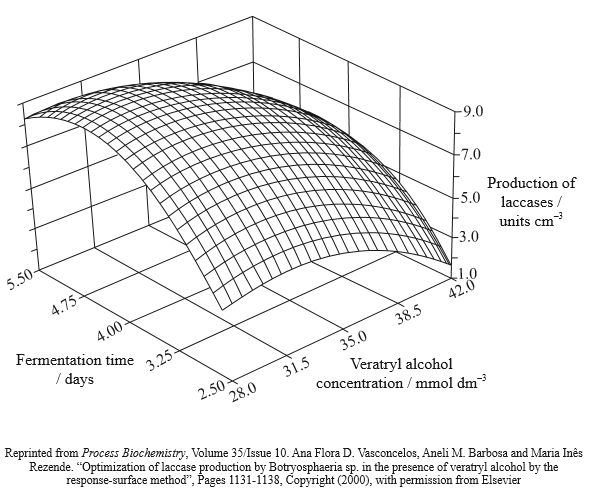
Identify the amount of laccases produced when the veratryl alcohol concentration is at its highest level and the fermentation time is at its shortest.
Identify the amount of laccases produced when the veratryl alcohol concentration is at its lowest level and the fermentation time is at its longest.
Analyse the overall effects of the veratryl alcohol concentration and fermentation time on the production of laccases.
Suggest two other conditions that might affect the production of laccases.
Answer/Explanation
Markscheme
1.6 (units) cm–3 (accept answers in range of 1.5 units cm–3 and 1.7 units cm–3)
8.3 (units) cm–3 (accept answers in range of 8.2 units cm–3 and 8.4 units cm–3)
as fermentation time increases laccase production rises then falls; (accept converse)
as veratryl alcohol concentration increases laccase production rises then falls; (accept converse)
optimum fermentation time is 4.75/5.0/5.25 days; (accept converse)
most laccase overall with low veratryl alcohol concentration and long fermentation; (accept converse)
optimum veratryl alcohol concentration is 33/34/35 mmol dm–3;
fermentation time has greater effect than veratryl alcohol concentration;
temperature;
pH;
oxygen concentration;
carbon dioxide concentration;
build up of waste/toxic products of metabolism;
amount of contamination;
light;
supply of raw materials/nutrients/sugar;
concentration of fungi;
presence of other fungi/bacteria;
Question
Outline the diversity of Eubacteria according to cell wall structure.
State the role of Rhizobium and Nitrobacter in the nitrogen cycle.
Rhizobium: …………………………………………………..
Nitrobacter: …………………………………………………..
Explain the use of bacteria in bioremediation.
Answer/Explanation
Markscheme
can be Gram-positive or Gram-negative;
Gram-negative have a thinner wall/less peptidoglycan/converse;
Gram-negative have an outer layer of lipopolysaccharide and protein;
Rhizobium: converts atmospheric nitrogen to ammonia / nitrogen fixation;
Nitrobacter: oxidizes nitrite into nitrate / nitrification;
bacteria remove contaminants from the environment;
by using them as energy sources;
(or) by converting them to a soluble/ harmless form;
example of bioremediation (e.g. Pseudomonas is used to clean up oil spills);
Question
The diagram below represents the cell walls of two different bacteria. State, with a reason, which cell wall (I or II) is Gram-positive.

Microorganisms play many roles in ecosystems. List two of these roles.
1. …………………………………………………………
2. …………………………………………………………
Answer/Explanation
Markscheme
I (is Gram-positive) because it has thick/outer layer of peptidoglycan/does not have outer layer (of lipids) external to peptidoglycan layer
producers / food source in aquatic environments;
nitrogen fixers / denitrifiers;
decomposers;
methane producers;
Question
Ethanol is an alternative energy source. Wheat straw can be converted into ethanol in two phases. Hydrolysis of complex polysaccharides in wheat straw (phase I) produces three monosaccharides (glucose, xylose and arabinose). Fermentation by yeast (Saccharomyces cerevisiae) then produces ethanol (phase II). The graph shows the changes in concentration of the three monosaccharides in both phases.
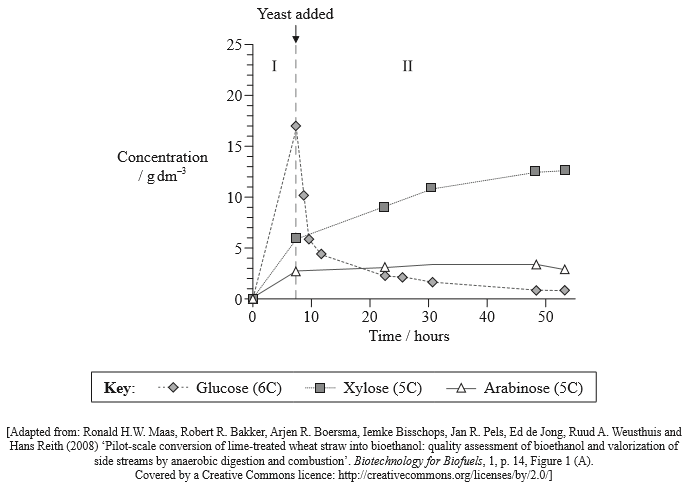
State the maximum concentration of glucose reached during the two phases, giving the units.
Distinguish between the changes in concentration of xylose and arabinose in phase II.
Explain the changes in concentration of glucose and xylose during phase II.
Suggest an advantage of the use of wheat straw as a source of energy.
Answer/Explanation
Markscheme
17 g dm–3 (accept answers in the range of 16.5 g dm–3 and 17.5 g dm–3)
concentration of xylose continues to increase while arabinose stays (approximately) constant;
concentration of xylose is always greater (than arabinose);
xylose concentration (appears to) stabilize at 50 hours while arabinose decreases slightly;
Do not accept answers stating numerical values alone.
glucose decreases/is used up due to fermentation/anaerobic respiration (by yeast);
xylose increases due to (continued) hydrolysis/production;
xylose not fermented by yeast / apparently yeast enzymes do not ferment 5-carbon sugars;
Do not accept xylose increasing due to breakdown of glucose
widely available / relatively inexpensive / waste product of food production / non-competitive with food applications / sustainable / renewable
Question
The electron micrograph below shows a thin section of the Gram-positive bacterium Micrococcus lysodeikticus.
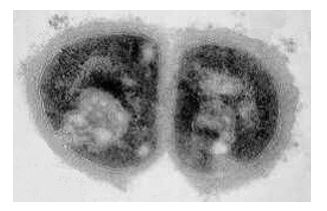
Compare the cell wall structure of this bacterium with one classified as Gram-negative.
Outline the role of saprotrophic bacteria in the treatment of sewage using reed bed systems.
Answer/Explanation
Markscheme
similarities:
both have walls made of murein net;
both have polysaccharide chains cross-linked by short peptide chains/ peptidoglycan;
differences:
Gram-positive have thicker/more rigid walls while Gram-negative walls are thinner;
Gram-positive walls contain other components/polysaccharides and proteins while Gram negative do not;
Gram-negative walls coated on outside with lipid-rich layer while Gram-positive are not;
To award [2 max] responses need to address a similarity and a difference.
bacteria cause decay by feeding on dead/decaying organic matter (in sewage);
nitrifying bacteria convert ammonia to nitrates /nitrites;
plant/reed roots absorb nitrates;
denitrifying bacteria convert nitrates to nitrogen;
Question
Distinguish between the cell walls of Gram-positive and Gram-negative bacteria using the table below.

Answer/Explanation
Markscheme
